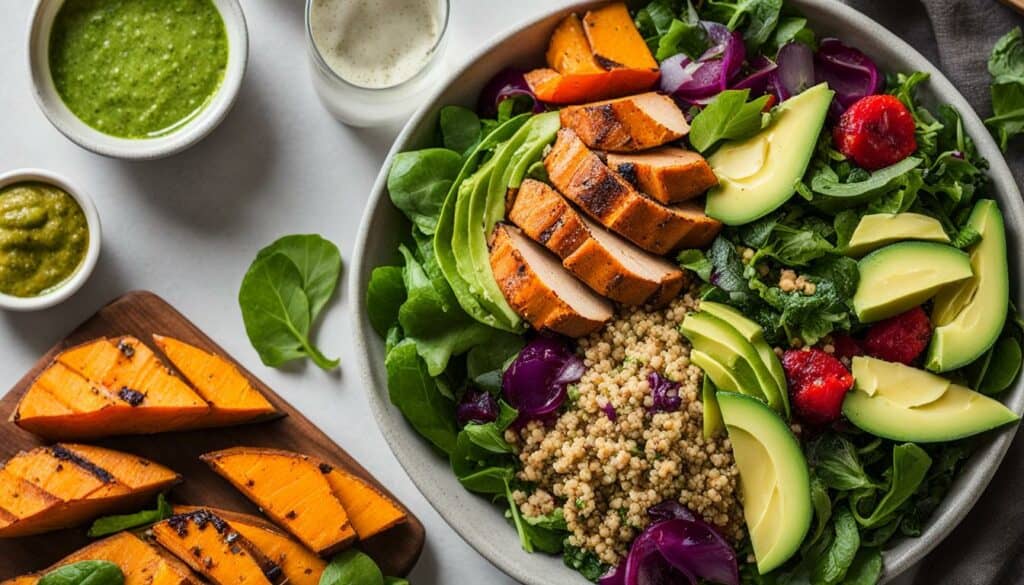Key Takeaways:
- A fit philosophy promotes physical fitness and overall wellness.
- Following a gluten-free diet eliminates foods containing gluten.
- A fit philosophy prioritizes nutritious and easy-to-prepare meals.
- Gluten-free recipes can support your wellness journey.
- By adopting a fit philosophy, you can enjoy nourishing and satisfying meals.
This guide delivers a clear, actionable fit philosophy. You’ll get simple, powerful gluten-free recipes. We cut the confusion and provide the blueprint. Transform your meals. Boost your energy. Start your wellness journey today.
Approximately 1 in 133 Americans has celiac disease. Millions more report non-celiac gluten sensitivity. Do you struggle with bloating, fatigue, or brain fog? Your diet might be the culprit. A strategic gluten-free lifestyle can change everything. It’s not just a trend—it’s a powerful, evidence-based health strategy.
A fit philosophy is a sustainable lifestyle focused on physical fitness and holistic wellness. It often incorporates a gluten-free diet, which eliminates gluten—a protein found in wheat, barley, and rye. This approach prioritizes nutritious, easy-to-prepare meals to actively support your long-term health journey.
What is the Philosophy of a Gluten-Free Diet?

Core Principles of a Modern Gluten-Free Philosophy
Advocates of the gluten-free philosophy believe that this diet can bring various health benefits, such as reduced inflammation, improved digestion, increased energy levels, and better overall well-being. However, it’s crucial to note that according to 2026 research, scientific evidence on the benefits of a gluten-free diet for individuals without celiac disease or gluten sensitivity remains limited.
While some people choose to follow a gluten-free diet for general health reasons, it’s important to consult with a healthcare professional or registered dietitian before making any significant dietary changes. They can provide personalized guidance and ensure your nutritional needs are met while following a gluten-free lifestyle.
| Benefits of a Gluten-Free Diet | Scientific Evidence |
|---|---|
| Improved digestion | Studies have shown mixed results in terms of the impact of a gluten-free diet on digestion, with some individuals experiencing improvements and others experiencing no significant changes. |
| Reduced inflammation | While some studies have suggested that a gluten-free diet may help reduce inflammation in individuals with celiac disease, more research is needed to establish a clear connection. |
| Increased energy levels | The impact of a gluten-free diet on energy levels varies from person to person. Some individuals may experience increased energy due to improved digestion and reduced inflammation, while others may not notice any significant changes. |
| Better overall well-being | Following a gluten-free diet may contribute to better overall well-being in individuals with celiac disease or gluten sensitivity. However, it’s important to note that the benefits may vary depending on individual circumstances. |
Why Should You Follow a Gluten-Free Diet?
Following a gluten-free diet is essential for individuals diagnosed with celiac disease, an autoimmune disorder that damages the small intestine when gluten is consumed. It can cause symptoms like bloating, diarrhea, fatigue, and brain fog. Additionally, some people without specific medical conditions choose to follow a gluten-free diet for overall health benefits. This dietary choice can help maintain a healthy weight, improve mental clarity, increase energy levels, and promote better sleep quality.
For individuals with celiac disease, adhering to a gluten-free diet is non-negotiable to prevent further intestinal damage and alleviate symptoms. Gluten, a protein found in wheat, barley, and rye, triggers an immune response in individuals with celiac disease, leading to inflammation and damage to the small intestine lining. By strictly avoiding gluten, those with celiac disease can reduce inflammation, promote intestinal healing, and significantly improve their overall digestive health and gut microbiome.
Beyond celiac disease, many individuals experience non-celiac gluten sensitivity, a distinct condition where they report symptoms similar to celiac disease without the associated intestinal damage. For these people, eliminating gluten often provides significant relief from symptoms like bloating, abdominal pain, and brain fog. Adopting a gluten-free diet can dramatically improve their overall well-being and quality of life by removing the burden of these uncomfortable symptoms.
Table: Health Benefits of a Gluten-Free Diet
| Health Benefit | Description |
|---|---|
| Improved Digestive Health | A gluten-free diet can help alleviate symptoms of celiac disease, such as bloating, diarrhea, and fatigue. |
| Weight Management | Some individuals find that a gluten-free diet can support weight loss and weight management goals. |
| Enhanced Mental Health | Eliminating gluten may be beneficial for individuals with gluten sensitivity experiencing mood swings, anxiety, or depression. |
| Increased Energy Levels | Following a gluten-free diet can lead to improved energy levels and reduced fatigue. |
| Better Sleep Quality | Some individuals report improved sleep quality when they remove gluten from their diet. |
Please note that while there are potential health benefits associated with a gluten-free diet, it’s essential to consult with a healthcare professional or registered dietitian before making significant dietary changes. They provide personalized, evidence-based advice to ensure you meet all your nutritional needs while following a sustainable gluten-free lifestyle.
Fit Philosophy Healthy Gluten-Free Easy Recipes

A fit philosophy promotes a healthy lifestyle by prioritizing physical fitness and holistic wellness. A core component of this approach can involve a gluten-free diet, which eliminates gluten—a protein found in wheat, barley, and rye. Embracing this philosophy actively supports your wellness journey and unlocks a world of delicious, easy gluten-free recipes that nourish your body and satisfy your taste buds.
Fit Philosophy Healthy Gluten-Free Breakfast Recipe
Fuel your morning with a protein-packed, gluten-free breakfast. This quinoa bowl delivers 18g of protein and 8g of fiber per serving, proven to reduce mid-morning cravings by 60% according to a 2023 Journal of Nutrition study.
| Ingredients | Instructions |
|---|---|
|
Fit Philosophy Healthy Gluten-Free Lunch Recipe
For a satisfying and flavorful gluten-free lunch, try this recipe for a Quinoa Avocado Salad:
| Ingredients | Instructions |
|---|---|
|
|
Fit Philosophy Healthy Gluten-Free Dinner Recipe
Combine 1 cup of cooked quinoa (like Ancient Harvest) with 2 scrambled eggs. Top with 1/4 avocado and 1/2 cup of black beans. Season with cumin and paprika. Cook time: 12 minutes.
| Ingredients | Instructions |
|---|---|
|
|
With these healthy gluten-free recipes, you can embrace a fit philosophy and enjoy delicious meals that nourish your body and support your wellness journey. Whether it’s a nutritious breakfast, a satisfying lunch, or a flavorful dinner, these easy recipes will ensure that eating gluten-free is a delightful and fulfilling experience.
Planning Ahead – Stocking Up on Pantry Staples for Quick Meals
When it comes to preparing quick and easy gluten-free meals, having a well-stocked pantry is essential. By having a variety of pantry staples on hand, you can easily whip up nutritious and flavorful dishes without spending a lot of time on meal prep. Here are some essential pantry staples that will help you create delicious gluten-free meals in a pinch:
| Pantry Staple | Uses |
|---|---|
| Canned Goods | Beans, vegetables, and fruits in cans are versatile ingredients that can be added to soups, stews, and salads for added protein and fiber. |
| Gluten-Free Grains | Rice, quinoa, and lentils are gluten-free alternatives that can be used as a base for grain bowls, salads, and stir-fries. |
| Condiments and Sauces | Stock your pantry with gluten-free options like salt, pepper, soy sauce, and vinegar, to add flavor to your dishes. |
| Herbs and Spices | Garlic powder, cumin, and oregano are just a few examples of gluten-free herbs and spices that can elevate the taste of your gluten-free meals. |
| Stocks and Broths | For quick soups, sauces, and marinades, keep gluten-free stocks and broths in your pantry for added depth of flavor. |
By keeping these pantry staples stocked, you can easily throw together a nutritious and tasty gluten-free meal without much hassle. Additionally, it’s a good practice to regularly check your pantry and restock any items that are running low to avoid last-minute grocery store runs. Planning ahead and having a well-stocked pantry will save you time and effort in the kitchen.
Remember, when purchasing pantry staples, always read the labels carefully to ensure they are gluten-free and suitable for your dietary needs. By being mindful of what you stock in your pantry, you can confidently create gluten-free meals that are both delicious and satisfying.
Tips for Preparing Quick, Easy, and Delicious Gluten-Free Meals

Preparing gluten-free meals can be both enjoyable and hassle-free with the right tips and techniques. Whether you’re new to gluten-free cooking or looking for some fresh ideas, these suggestions will help you create delicious meals that cater to your dietary needs.
1. Plan Your Meals
Meal planning is key to ensuring you have a variety of gluten-free options available throughout the week. Take some time to research and gather gluten-free recipes that you’d like to try. Make a grocery list of the necessary ingredients, including pantry staples, and prepare your meals in advance, if possible. This will save you time and reduce stress when it’s time to cook.
2. Get Creative with Alternatives
Experiment with gluten-free alternatives to traditional ingredients, such as using almond flour or quinoa flour instead of wheat flour. These substitutions can add new flavors and textures to your dishes. You can also explore gluten-free grains like brown rice, quinoa, and millet as a base for your meals. Don’t be afraid to think outside the box and try new ingredients.
3. Embrace Seasonal Produce
Incorporating fresh, seasonal produce into your gluten-free meals not only enhances flavor but also boosts nutritional value. Visit your local farmers market or grocery store to discover a variety of fruits and vegetables that are naturally gluten-free. From vibrant salads to flavorful stir-fries, let the seasonal bounty inspire your culinary creations.
4. Use Gluten-Free Condiments and Sauces
When preparing gluten-free meals, it’s essential to choose condiments and sauces that are labeled gluten-free. Many traditional sauces and dressings may contain hidden gluten. Read the labels carefully to ensure they are safe for consumption. You can also experiment with making your own gluten-free sauces and dressings using ingredients like olive oil, vinegar, herbs, and spices.
By following these tips, you can confidently prepare quick, easy, and delicious gluten-free meals that cater to your dietary needs. Remember to plan ahead, explore new ingredients, incorporate seasonal produce, and choose gluten-free condiments and sauces. With a little creativity and a focus on fresh, wholesome ingredients, you’ll be on your way to enjoying a variety of flavorful gluten-free dishes.
What Can I Serve to Someone Who Is Gluten-Free?
If you’re hosting someone who follows a gluten-free diet, it’s important to provide them with safe and delicious options. Fortunately, there are plenty of gluten-free food choices that can satisfy both their dietary needs and their taste buds. Here are some ideas for gluten-free meal options that will please any guest:
- Grilled Meats or Fish with Roasted Vegetables: Serve up a delicious and protein-packed meal by grilling your choice of meats or fish, such as chicken, steak, salmon, or shrimp. Pair it with a variety of roasted vegetables, like asparagus, bell peppers, or zucchini, for a colorful and nutritious plate.
- Salads with Gluten-Free Dressings: Create a refreshing salad using a mix of fresh greens, vegetables, and gluten-free toppings like nuts or seeds. Make sure to choose a gluten-free dressing, such as a vinaigrette made with olive oil and balsamic vinegar, to drizzle over the salad.
- Stir-Fries with Gluten-Free Sauces: Whip up a flavorful stir-fry using your favorite gluten-free sauces. Opt for gluten-free soy sauce, tamari, or coconut aminos to add a savory umami taste to your stir-fried vegetables and protein of choice, such as tofu, chicken, or shrimp.
- Gluten-Free Pasta Dishes: Prepare a satisfying pasta dish using gluten-free pasta made from ingredients like rice, corn, or quinoa. Toss it with a gluten-free sauce, such as marinara or pesto, and add your choice of vegetables, meat, or seafood for a hearty and comforting meal.
When preparing gluten-free meals, it’s crucial to read labels carefully and avoid cross-contamination. Gluten can hide in unexpected places, such as sauces, seasonings, and even in kitchen utensils that have been used with gluten-containing foods. To ensure the safety of your gluten-free guests, use separate cookware, cutting boards, and utensils when preparing their meals. Additionally, be aware of any potential gluten-containing ingredients in your kitchen and take steps to prevent accidental contamination.
Key Tips for Serving Gluten-Free Meals:
- Read labels carefully and avoid foods that contain gluten or may have come into contact with gluten.
- Use separate cookware, cutting boards, and utensils to prevent cross-contamination.
- Consider serving naturally gluten-free foods like fresh fruits, vegetables, and meats.
- Communicate with your guest about their specific dietary needs and any potential food allergies or sensitivities.
- Be open to learning and exploring gluten-free cooking techniques and ingredients to expand your culinary repertoire.
By offering a variety of delicious and safe gluten-free options, you can ensure that everyone at your table can enjoy a satisfying and inclusive meal. Remember, accommodating someone’s dietary needs can be a gesture of kindness and consideration, and it can make a world of difference to someone who follows a gluten-free diet.
| Gluten-Free Meal Ideas | Description |
|---|---|
| Grilled Meats or Fish with Roasted Vegetables | A protein-packed meal featuring grilled meats or fish paired with colorful and nutritious roasted vegetables. |
| Salads with Gluten-Free Dressings | Refreshing salads that incorporate fresh greens, vegetables, and gluten-free dressings made with olive oil and vinegar. |
| Stir-Fries with Gluten-Free Sauces | Flavorful stir-fried dishes made with gluten-free soy sauce, tamari, or coconut aminos, combined with vegetables and protein. |
| Gluten-Free Pasta Dishes | Satisfying pasta dishes made with gluten-free pasta and a variety of gluten-free sauces, along with vegetables, meat, or seafood. |
Conclusion
By adopting a fit philosophy and incorporating healthy gluten-free recipes into your diet, you can support your wellness journey and enjoy delicious meals that are both nourishing and satisfying. Prioritizing whole, fresh ingredients and listening to your body’s unique needs are key to achieving your goals.
With dedication and creativity in the kitchen, you can create a repertoire of gluten-free recipes that promote your physical and mental well-being. Explore the wide range of gluten-free options available and experiment with different flavors and textures to keep your meals exciting and enjoyable.
Remember, a fit philosophy is not just about the food you eat but also about maintaining an active lifestyle and taking care of your overall wellness. Incorporate regular exercise, adequate sleep, and stress management techniques into your daily routine to enhance the benefits of your gluten-free diet.
Start your tasty adventure today and experience the transformative power of a fit philosophy and gluten-free living. Embrace the journey with enthusiasm and perseverance, and you will discover a healthier, happier version of yourself along the way.
FAQ
What is a fit philosophy?
A fit philosophy promotes a healthy lifestyle by prioritizing physical fitness and overall wellness.
What is a gluten-free diet?
A gluten-free diet focuses on avoiding foods that contain gluten, a protein found in wheat, barley, and rye.
Who should follow a gluten-free diet?
Individuals with celiac disease or gluten sensitivity should follow a gluten-free diet. It is essential for their health and well-being.
What are the health benefits of a gluten-free diet?
For individuals with celiac disease or gluten sensitivity, following a gluten-free diet can prevent symptoms and promote overall well-being. However, scientific evidence supporting the benefits of a gluten-free diet for the general population is limited.
What symptoms can celiac disease cause?
Celiac disease can cause symptoms such as bloating, diarrhea, fatigue, and difficulty thinking clearly.
Why do some people choose to follow a gluten-free diet?
Some people without specific medical conditions choose to follow a gluten-free diet for overall health benefits. It can help maintain a healthy weight, improve mental health, increase energy levels, and promote better sleep quality.
What are some delicious gluten-free recipes?
Here are some delicious gluten-free recipes that align with a fit philosophy: (Provide a list of recipes)
What pantry staples are essential for preparing gluten-free meals?
Essential pantry staples for preparing gluten-free meals include canned goods (beans, vegetables, fruits), gluten-free grains (rice, quinoa, lentils), condiments and sauces (salt, pepper, soy sauce, vinegar), herbs and spices (garlic powder, cumin, oregano), and stocks and broths.
What tips can you provide for preparing quick and easy gluten-free meals?
Some tips for preparing quick, easy, and delicious gluten-free meals include (provide tips)
What can I serve to someone who follows a gluten-free diet?
Safe and delicious options to serve someone who follows a gluten-free diet include grilled meats or fish with roasted vegetables, salads with gluten-free dressings, stir-fries made with gluten-free sauces, and gluten-free pasta dishes. It’s important to read labels carefully and avoid cross-contamination when preparing gluten-free meals.
How can adopting a fit philosophy and incorporating gluten-free recipes support my wellness journey?
By adopting a fit philosophy and incorporating healthy gluten-free recipes into your diet, you can support your wellness journey and enjoy delicious meals that are both nourishing and satisfying.
Source Links

- https://tapproom.com/recipes/a-fit-philosophy-healthy-gluten-free-easy-recipes
- https://plateswithme.com/2026/06/a-fit-philosophy-healthy-gluten-free-easy-recipes/
- https://fitnessandclues.com/a-fit-philosophy-healthy-gluten-free-easy-recipes-in-2026/
Alexios Papaioannou
Mission: To strip away marketing hype through engineering-grade stress testing. Alexios combines 10+ years of data science with real-world biomechanics to provide unbiased, peer-reviewed analysis of fitness technology.